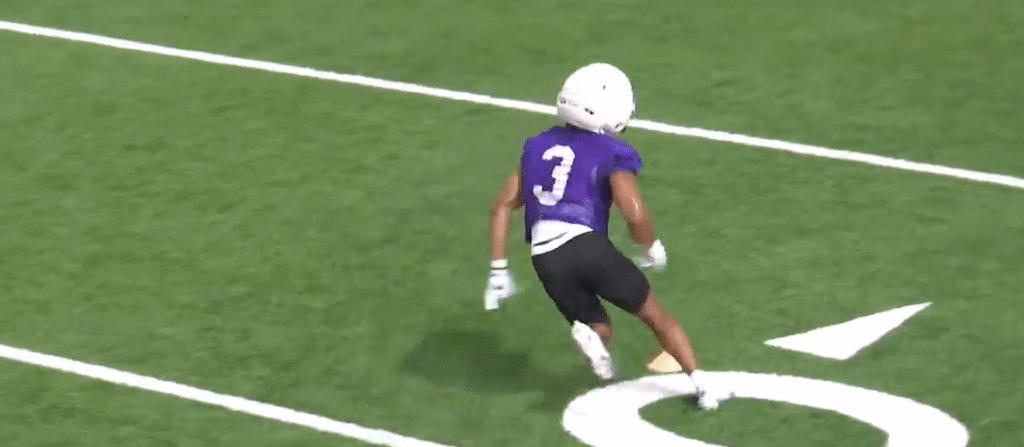The storyline of Dylan Edwards leaving Kansas State seems to be full of drama, disappointment, and tenacity. Supporters had hailed him as the Wildcats’ backfield’s future face, but his decision to leave has become eerily reminiscent of the changes in contemporary sports, where loyalty sways under the weight of unmet expectations and ambition.
Without his explosive speed, Kansas State’s offense has appeared noticeably diminished in recent days. The Wildcats barely defeated North Dakota, but their inability to control the tempo was greatly diminished by Edwards’ absence. Even though Avery Johnson threw for over 300 yards, the rushing attack lost its equilibrium without Edwards. It served as a strikingly powerful reminder of how essential Edwards was to the Wildcats’ plan.
His departure is all the more painful for those who witnessed him tearing apart Rutgers in the 2024 Rate Bowl. With 196 rushing yards and two touchdowns that evening, Edwards’ performance was a blatant example of his capacity to lead a team on the biggest stage. Today, it reads more like a farewell letter Kansas State fans never anticipated, but that game felt like a prophecy.
Dylan Edwards – Bio Data and Career Information
| Field | Information |
|---|---|
| Full Name | Dylan Edwards |
| Date of Birth | 2005 (age 20 as of 2025) |
| Height / Weight | 5 ft 9 in (1.75 m) / 170 lbs (77 kg) |
| Position | Running Back |
| High School | Derby High School (Derby, Kansas) |
| College Career | Began at Colorado; transferred to Kansas State in April 2024 |
| Notable Stats | 2024 season: 679 scrimmage yards, 8 touchdowns; MVP of 2024 Rate Bowl |
| Achievements | Set K-State bowl record with 196 rushing yards vs. Rutgers in Rate Bowl |
| Recent Issues | Ankle injury in 2025 season opener vs. Iowa State; missed multiple games |
| Departure Reason | Reports suggest unfulfilled promises between Edwards and Kansas State staff |
| Reference | CBS Sports |

According to reports, the breakup resulted from unfulfilled promises. Edwards is reported to have felt that the promise made to him was not kept, regardless of whether it was regarding playing time, NIL opportunities, or role clarity. His departure is particularly innovative in that regard—not in a tactical sense, but rather in the way it draws attention to the widening gap between rhetorical recruitment and actual delivery. Edwards views leaving as an act of assertion rather than abandonment.
It is impossible to overlook the emotional impact of his choice. In a sobering reminder of how athletes are scrutinized for both their presence and absence, Edwards acknowledged that he received hate mail following his ankle injury. His experience is remarkably similar to that of international celebrities like Naomi Osaka, who took a backseat to ensure her safety. For Edwards, leaving could be as much about mental tranquility as it is about potential opportunities in the future.
Chris Klieman, the coach of Kansas State, who is renowned for his steady leadership, acknowledged uncertainty but refrained from criticizing directly. He cited Edwards’ continuous recuperation from his injury, but his silence regarding the transfer discussion was more powerful than words. Losing a star back who grew up in Kansas is more than just a roster change for a program hoping to establish itself in the Big 12. It is a cultural setback.
This choice is not unique. Players in college football are increasingly adopting strategies similar to professional sports free agency. Athletes like Edwards are taking back control of their own trajectories, much like LeBron James changed the NBA landscape with his career decisions. When promises are broken, Edwards’ case demonstrates how effective the transfer portal can be. It can be used as a launchpad or an escape hatch.
Kansas State is immediately affected. A local star who became a collegiate hero, Edwards was a homegrown talent whose presence enhanced marketing campaigns and recruitment pitches. His absence has a particularly long-lasting effect on the team’s performance and the program’s perceived stability. Such departures are noticed by recruits and their families, and in a time when NIL deals determine futures, appearances are just as important as results.
Nevertheless, the future holds promise. Edwards will have suitors thanks to his talent. Programs eager for quickness and creativity will align with him, and his ability to breach defenses makes him a very dependable difference-maker. He will take the lessons he learned from Kansas State with him wherever he ends up, even though it was a difficult chapter that might ultimately help his career.
Adapting is now Kansas State’s challenge. Joe Jackson and other backs take on more of the rushing load, and Avery Johnson must lead with poise. The team needs to rethink its offensive strategy in terms of both play design and mindset. Edwards’ absence presents both a challenge and a chance to demonstrate resiliency. If properly accepted, this loss may lead to expansion that will be especially advantageous for the program’s long-term development.

